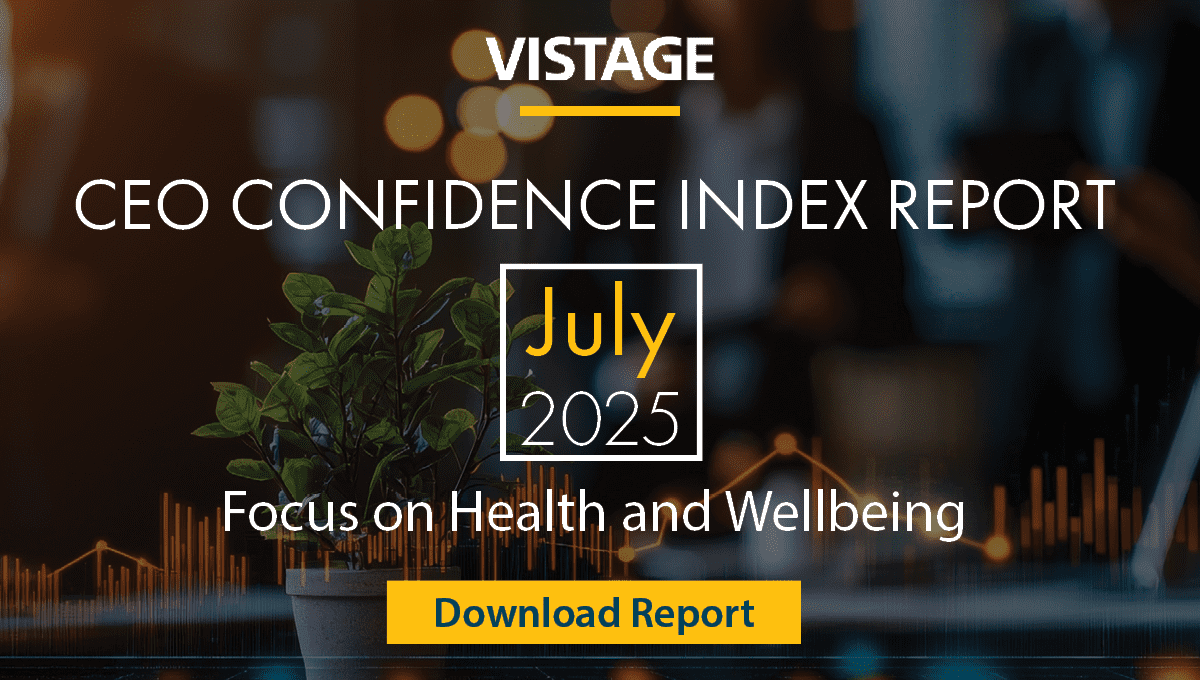You are here: Home / Leadership Insights / Leadership / CEO wellbeing and resilience: A leadership risk in focus [Vistage CEO Index July 2025]

CEO wellbeing and resilience: A leadership risk in focus [Vistage CEO Index July 2025]

As economic uncertainty and operational complexity continue to challenge business leaders, a quieter but equally critical issue is emerging: the wellbeing of CEOs themselves.
The latest data from the Vistage CEO Confidence Index (July 2025) highlights a concerning trend—leaders are shouldering increasingly unsustainable levels of pressure. Burnout, disrupted recovery routines, and difficulties in maintaining work-life boundaries are not just personal struggles—they’re strategic risks.
The strain behind the strategy
Only 8% of surveyed CEOs reported an excellent work–life balance. While 41% described theirs as good, nearly 30% said it was only fair, and 10% admitted their work–life balance was non-existent.
When it comes to burnout:
- 40% of CEOs have felt burned out occasionally over the past three months
- 24% experienced it frequently
- 6% reported feeling burned out nearly every day
This means over 70% of CEOs are operating under some level of emotional or physical strain.
What’s causing the pressure?
In their own words, CEOs pointed to a mix of structural and personal stressors:
- “Weekly travel between 4 different states with 2 young children at home…”
- “Balancing cashflow with uncertain international conditions…”
- “Lack of skilled middle managers”
- “We’re going through a sale process”
- “Not sticking to my routine… missing gym sessions, turning the computer back on after hours”
These aren’t minor gripes—they reflect an ecosystem of demands that leave little space for recovery, even when leaders recognise the need.
From robust to resilient
As Dr Sven Hansen from the Resilience Institute explains, resilience is not about toughness—it’s about adaptability and recovery. Many leaders confuse being “robust” (pushing through) with true resilience, which is marked by agility, self-awareness, and the ability to bounce back.
He identifies four resilience states:
- Fragile: At risk of breaking under stress
- Robust: Surviving but drained and joyless
- Resilient: Agile, self-aware, and adaptive
- Anti-fragile: Strengthened through adversity (the elite few)
Burnout, he notes, is often misdiagnosed. It’s not a failing—it’s a signal to reassess rhythm, routines, and self-care.
Rhythm before resilience
Survey data shows that while 70% of CEOs adjust their workload when overwhelmed, many still struggle with foundational rhythms:
- 39% struggle with sleep
- 58% say their schedule interferes with regular exercise
- 53% have trouble disconnecting, even during time off
Sven’s advice? Start with rhythm:
- Prioritise daily disciplines—sleep, breathwork, movement
- Take micro-breaks and seek nature exposure during the day
- Audit your energy and identify your three non-negotiables
When leaders restore their rhythms, they regain clarity, patience, and performance.
Self-awareness: The essential skill
Sven reminds us that the most powerful leadership tool is self-awareness. CEOs who regularly check in on their physical, emotional, and cognitive state are far more effective at leading through complexity.
He suggests brief team check-ins on “flow, control, and worry” to normalise wellbeing conversations and build collective resilience.
Why it matters
CEO wellbeing is no longer just a personal matter—it’s a leadership competency. An exhausted leader is less strategic, less creative, and more reactive. The risks of ignoring wellbeing ripple across company culture, decision-making, and ultimately, long-term performance.
The path forward
What can be done? It starts with small, consistent shifts:
- Schedule non-negotiable downtime
- Set clear digital boundaries after hours
- Embrace tools like breathwork and flow state planning
- Engage with a peer group that supports both business and personal growth

Final thought
If you’re a CEO or business leader reading this, ask yourself: Am I resilient—or just robust?
Leadership demands energy, clarity, and adaptability. And those don’t come from pushing harder—they come from recovering smarter.
CEO Confidence Index – July 2025 Report
The Vistage CEO Confidence index surveys small to mid-sized business CEOs and owners across Australia. The latest index results reveals the economic challenges facing Australian businesses with a focus on the workforce.




